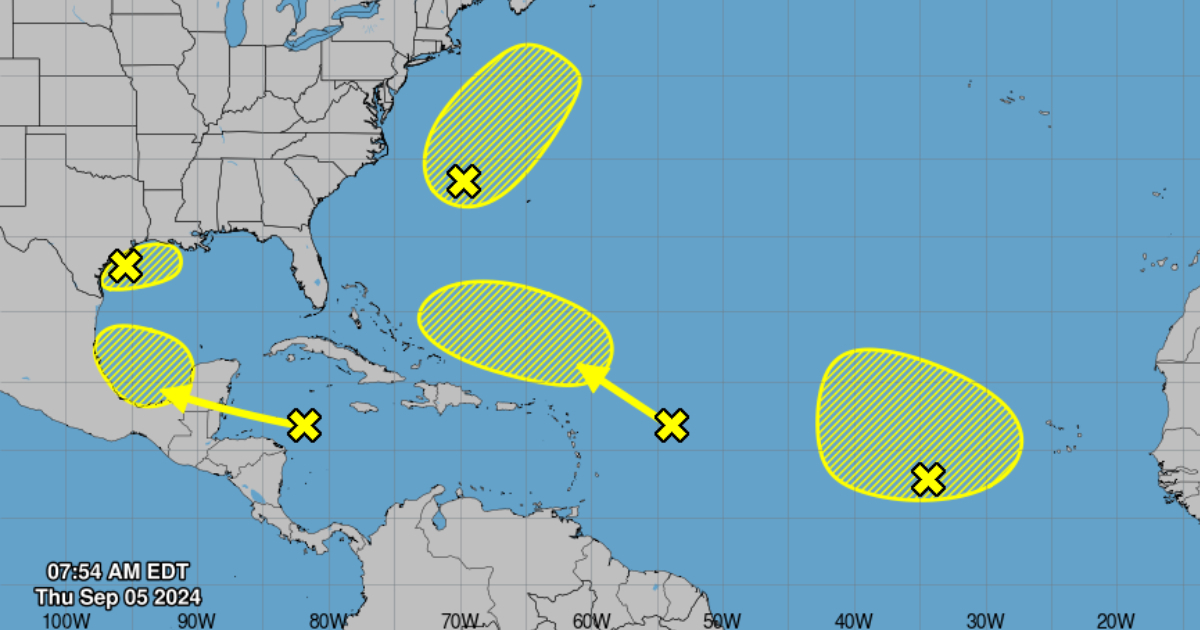
Just a few days before the peak of the hurricane season, the North Atlantic, the Caribbean Sea, and the Gulf of Mexico are experiencing five disturbances that, despite having low chances of development, are being closely monitored by the National Hurricane Center (NHC) in the United States.
In the northwest Gulf of Mexico, a low-pressure trough is producing disorganized rain and thunderstorms near the coasts of Louisiana and Texas. However, upper-level winds are expected to hinder its development in the coming days due to the approach of a front, and the NHC has warned that tropical development is unlikely.
However, the agency warned that intense rain is expected in parts of the northern Gulf coast, with a 10% chance of formation in both the next 48 hours and the upcoming seven days.
On the other hand, in the northwest Atlantic, a non-tropical low-pressure area located east of North Carolina is causing scattered rain and thunderstorms.
According to the NHC, there is a possibility that this system will acquire subtropical characteristics in the coming days as it moves northeastward, although no significant development is expected after Saturday. The probability of formation in 48 hours is 20%, and it remains at 20% over the next seven days.
In the eastern tropical Atlantic, a large area of low pressure is causing disorganized storm activity. This system could gradually develop as it moves northwest or north over the next few days, with a 10% chance of formation in the next 48 hours and a 20% chance over the next seven days.
In the northwest Caribbean Sea and the southwest Gulf of Mexico, a tropical wave is moving westward, producing a slight increase in rainfall and thunderstorms.
Although it is unlikely to develop before reaching Belize and the Yucatán Peninsula on Friday, there is a small chance of development once it emerges in the southwest Gulf of Mexico over the weekend. The probability of formation in 48 hours is nearly zero, but it increases to 30% over the next seven days, according to the NHC.
Finally, the monitoring center reported a tropical wave in the central Atlantic, east of the Windward Islands, which is producing minimal rain and thunderstorms.
However, strong winds in the upper levels are limiting its short-term development. Starting next week, conditions could become more favorable for slow development in the southwestern Atlantic. The probability of formation in 48 hours is nearly zero, and remains low at 10% over the next seven days.
Cuban meteorologist Raydel Ruisanchez warned on Facebook this Thursday that “we are less than a week away from the peak of cyclone activity, and so far everything has been quite calm, but this is expected to start changing.”
Evidence of this "surge" is that last Tuesday, the NHC warned that they were monitoring three tropical waves in the Atlantic and the Caribbean Sea, indicating that they had the potential to develop into tropical depressions in the Atlantic region. Just a few days later, there are now five disturbances being closely watched by specialists.
In August, the National Oceanic and Atmospheric Administration (NOAA) revised its forecast, confirming that up to 13 cyclones could form.
The new report indicates a slight yet significant adjustment in NOAA's forecasts, which estimate a range of 17 to 24 named storms (with winds of 39 mph or greater) and between 8 to 13 hurricanes (with winds of 74 mph or greater).
Filed under: